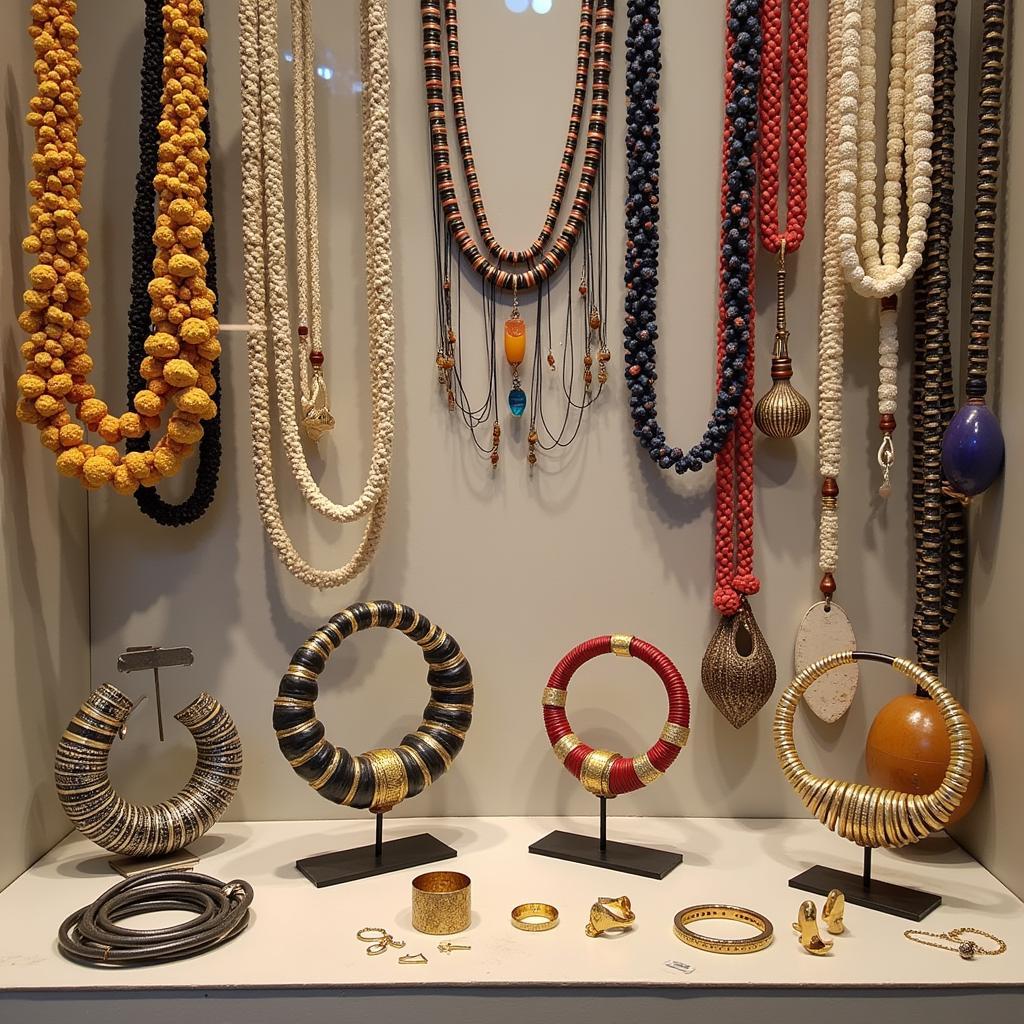Exploring the Beauty of African Jewelry from Ghana
Ghana, located in West Africa, boasts a rich cultural heritage reflected in its vibrant art, music, and fashion. One of the most captivating aspects of Ghanaian culture is its traditional jewelry, renowned for its exquisite craftsmanship and symbolic significance. This article delves into the world of African Jewelry From Ghana, exploring its history, materials, techniques, and cultural relevance.
Ghana has a long and illustrious history of jewelry making, dating back centuries. Archaeological evidence suggests that gold, ivory, and beads have been used to create ornaments in the region since ancient times. The Ashanti people, known for their mastery of goldsmithing, established a powerful kingdom in the 17th century, and their intricate jewelry became a symbol of wealth, power, and spiritual connection.
The Significance of Ghanaian Jewelry
Beyond its aesthetic appeal, African jewelry from Ghana holds profound cultural and spiritual significance. Each piece tells a story, conveying messages about social status, tribal affiliation, and personal beliefs. For instance, the “akrafokonmu” symbol, often found in Ashanti jewelry, represents courage and leadership. Similarly, the “sankofa” symbol, depicting a bird looking backward while carrying an egg in its beak, signifies the importance of learning from the past to build a better future.
Materials and Techniques
Ghanaian artisans employ a diverse range of materials and techniques to create their stunning jewelry. Gold, often sourced from local mines, holds a special place in Ghanaian culture. The Ashanti people, in particular, are renowned for their exceptional goldsmithing skills. Using traditional lost-wax casting methods, they transform molten gold into intricate designs, often featuring symbolic motifs and elaborate patterns.
Besides gold, other materials commonly used in Ghanaian jewelry include:
- Beads: Beads hold immense cultural significance in Ghana and are used extensively in jewelry making. They come in various materials, including glass, wood, bone, clay, and metal.
- Brass: This alloy of copper and zinc is valued for its durability and warm, golden hue.
- Copper: Known for its reddish-brown color, copper is often used to create bold and striking pieces.
- Wood: Lightweight and versatile, wood is often carved into intricate shapes and adorned with beads or metal accents.
Types of Ghanaian Jewelry
From earrings and necklaces to bracelets and rings, African jewelry from Ghana encompasses a wide range of styles and designs. Some of the most popular types include:
- Beaded necklaces: These necklaces often feature multiple strands of colorful beads, arranged in intricate patterns. The choice of colors and patterns can hold specific meanings and may vary depending on the occasion or the wearer’s ethnicity.
- Gold weights: Historically used as a form of currency by the Ashanti people, gold weights are miniature sculptures crafted in various shapes, representing animals, plants, objects, and proverbs. Today, they are prized as collectible items and often incorporated into jewelry.
- Krobo beads: These large, handcrafted beads are made from recycled glass and are highly sought after by collectors and jewelry enthusiasts worldwide.
- Filigree jewelry: This delicate and intricate style of jewelry involves twisting and soldering thin wires of gold or silver to create elaborate patterns.
 Variety of Ghanaian Jewelry
Variety of Ghanaian Jewelry
Ghanaian Jewelry in Contemporary Fashion
African jewelry from Ghana has transcended cultural boundaries and gained international recognition as a unique and stylish accessory. Contemporary Ghanaian designers are fusing traditional techniques with modern aesthetics, creating innovative and eye-catching pieces that appeal to a global audience. The use of bold colors, geometric patterns, and symbolic motifs has made Ghanaian jewelry a favorite among fashion-forward individuals looking to make a statement.
Caring for Your Ghanaian Jewelry
Proper care and storage are essential for preserving the beauty and longevity of your African jewelry from Ghana:
- Gold jewelry: Clean gently with a soft cloth and store in a dry, airtight container.
- Beads: Avoid exposing beads to excessive moisture or heat, as this can cause damage or discoloration. Store beaded jewelry flat to prevent stretching or tangling.
- Brass and copper: These metals can tarnish over time. Gently clean with a polishing cloth designed for these materials.
Where to Find Authentic Ghanaian Jewelry
When purchasing African jewelry from Ghana, it is essential to ensure its authenticity and support ethical sourcing practices. Reputable dealers, fair trade organizations, and online marketplaces specializing in African crafts are good places to start your search. By choosing authentic Ghanaian jewelry, you not only acquire a beautiful piece but also contribute to the preservation of a rich cultural heritage.
Expert Insight:
“Ghanaian jewelry is more than just adornment; it’s a reflection of the country’s soul,” says Adwoa Agyekum, a renowned Ghanaian jewelry designer. “Each piece tells a story, passed down through generations, keeping our traditions alive.”
Ghanaian jewelry is a testament to the creativity and cultural richness of the Ghanaian people. From the intricate goldwork of the Ashanti to the vibrant beadwork of various ethnic groups, each piece holds a story and a significance that transcends its material value. Whether you are drawn to its traditional designs or its contemporary interpretations, African jewelry from Ghana is a timeless and captivating art form that continues to fascinate and inspire.



